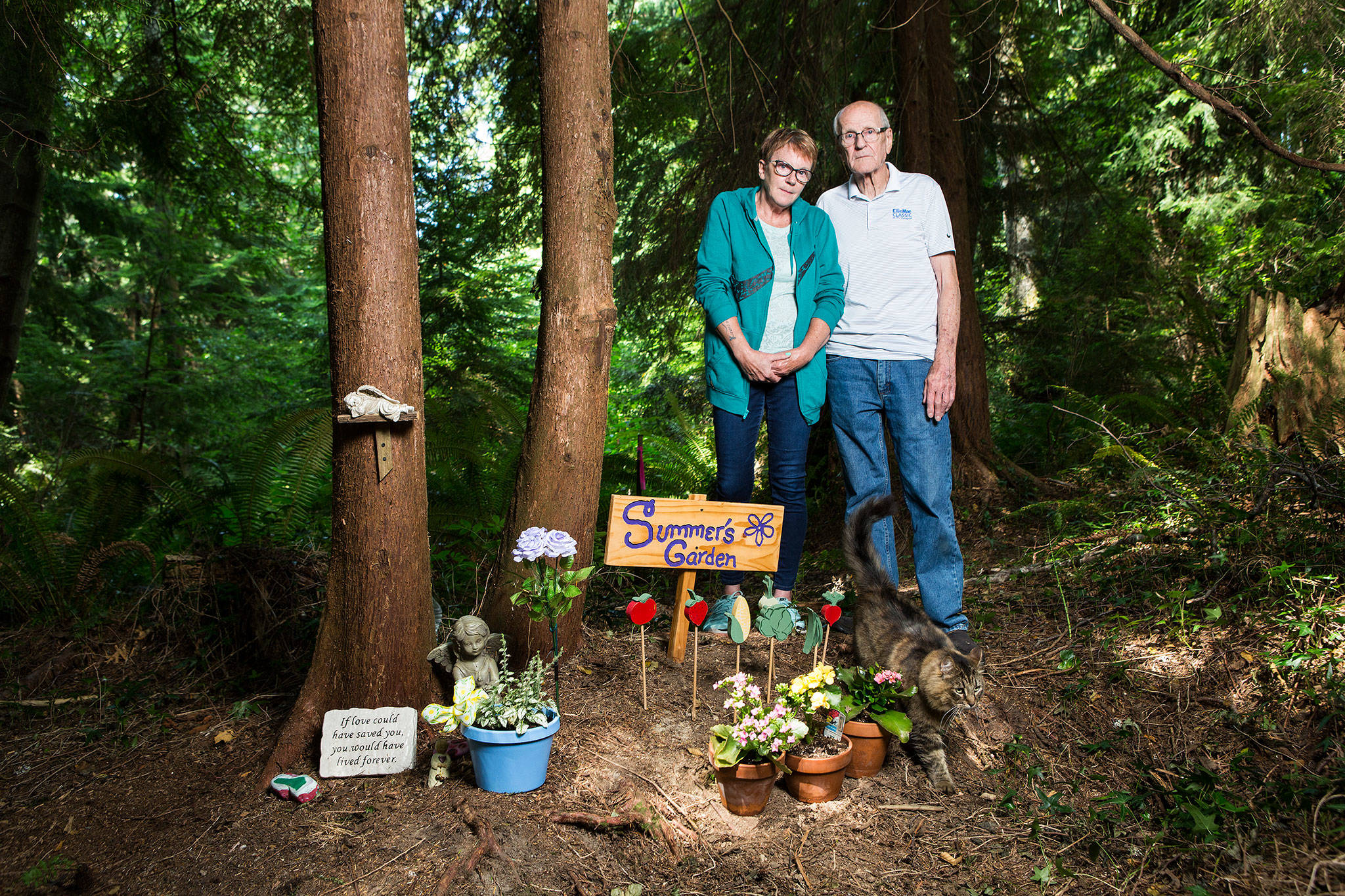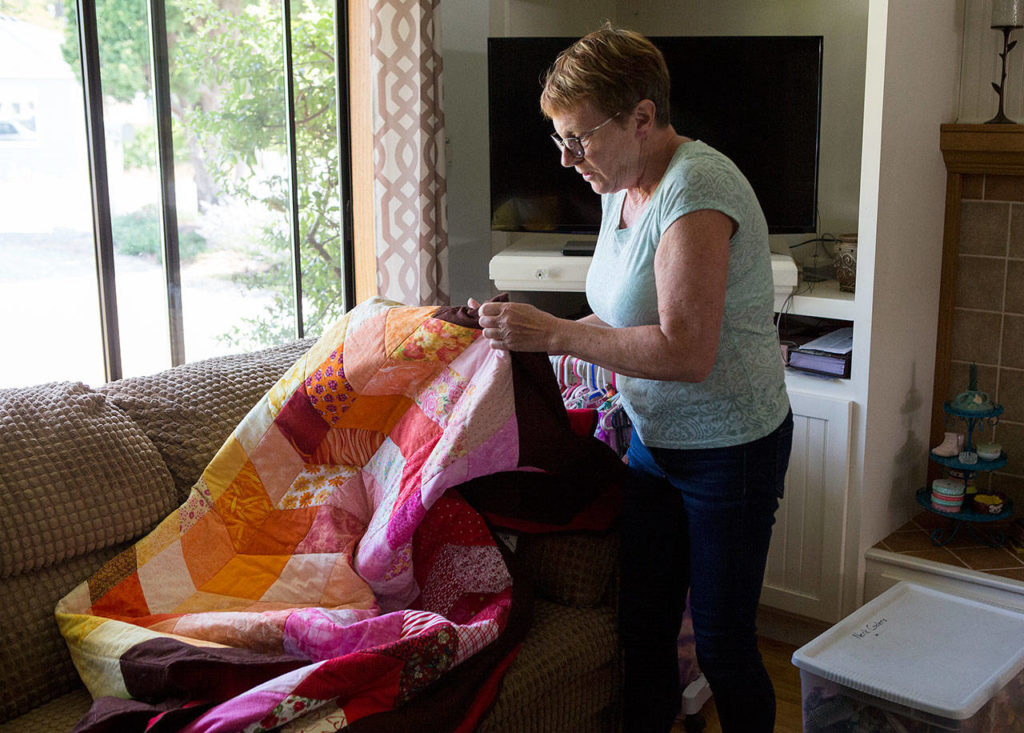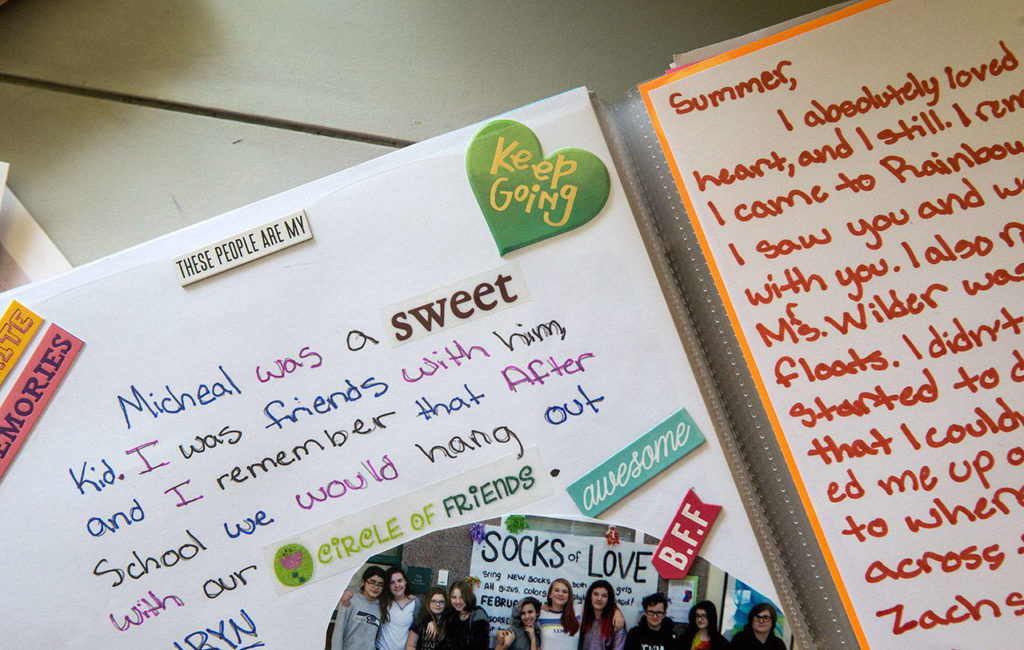EVERETT — Summer Rae Dolman told her family she was going out back to draw.
On nice days, she would follow a dirt path from the sloped yard. The path leads into the woods near Pigeon Creek. She’d spend hours there sketching.
Her great-grandfather pulled a casserole out of the oven for dinner on April 30. It was after 6 p.m., and Summer had been out back about an hour and a half. Her grandmother called and texted, but Summer didn’t respond. They went to look for her.
Her grandmother returned to the house, thinking Summer might have gone to her room.
Her great-grandfather found her in the woods.
She’d hanged herself. She was 13.
Summer was in seventh grade at Evergreen Middle School. Among the loved ones she left behind are younger half-brothers, uncles who were like older brothers, and friends who have memorialized her in art, letters and flowers.
Drawings by Summer of flowers and plants adorn the walls of her family’s home. A photo collage in the hallway features baby Summer, big eyes and curly hair and a photo-perfect smile. The backdrop is purple paper, her favorite color.
Summer was fiercely independent even as a toddler, her great-grandfather said. As she got older, she found a love for art, swimming and the outdoors. She’d recently gone shopping for a new swimsuit. The end of the school year and the promise of hot weather were less than two months away.
In the weeks before she died, she seemed happy, her family said.
But Summer had been thinking about suicide for months. She’d written at least two notes. After her death, her grandmother found one dated Jan. 17. The second was dated the day she died.
Summer wrote down the names of friends and family and asked for them to be told she loved them. The note from January ends with “I love you,” scrawled in letters larger than any others on the page.
The last words of her final note are: “Tell everyone I’m sorry and I love them.”
‘To hear your laughter’
Summer lived with her grandmother, Liz Stevenson, 60, for the past five years. They were in the same house in north Everett where Stevenson spent much of her childhood. Stevenson’s father, Al Crippen, 81, also lives there. Summer’s father died in 2013 and her mother has battled drug addiction.
Stevenson volunteers at the school, where Summer was part of Rainbow Unity Club, a group created as a safe space for students regardless of gender identity or sexual orientation. Stevenson has a rainbow quilt made in Summer’s honor, with a purple heart signed by friends stitched on the back.
A scrapbook preserves dozens of photographs, sketches and notes. Some are written to Summer, others to Michael. The seventh-grader was questioning her gender identity and had gone by both names in middle school. Before her death, she identified as a girl. She signed her last note as “Summer,” the name she was born with.
Written messages describe a young person who made friends laugh, an artist and a goofball who had their backs. Some friends drew her as an anime character. Summer liked Japanese animation.
“Every time I came to Rainbow Unity I wanted to hear your laughter,” one friend wrote. “It made my day better.”
Students planted flowers outside the school in May. A close friend and his grandfather made a sign that says “Summer’s Garden.”
Stevenson plans to keep volunteering. She aims to start a campaign of kindness with a focus on ending bullying.
After Summer’s death, Stevenson found a folded note in Summer’s dresser that she believes had at some point been slipped into the teen’s locker. Cruel messages are scribbled on it. Among them: “You, jump off the school roof” and “Die you lgbt.”
The night Summer died, school administrators talked with Stevenson about the message they would share with students. An announcement at school urged them not to spread rumors “like she was bullied.”
“Let’s honor Summer by putting the same effort into our school and friends as she did,” the announcement said.
“I did not want to say that her death was because of bullying,” Stevenson said during an interview in June.
There’s no single cause of suicide. Summer was hurting emotionally. She’d cut herself in the past.
“This year had been the hardest year for Summer,” Stevenson said. “… She was shutting down.”
Summer faced the turmoil of middle school combined with questioning her gender identity, wanting to see her mother more and absorbing hurtful words from some of her peers.
Stevenson wants families to be more involved in supporting teens who are suffering and in holding young people accountable for how they treat others.
She won’t stay silent.
“If I can make a difference and save one kid’s life, that’s my mission,” Stevenson said. “I always told Summer: Right the wrong.”
The dark place
Wendy Burchill with the Snohomish Health District has reviewed child deaths in Snohomish County for 16 years.
When she started, there were few youth suicides, and some years none. The tally certainly didn’t include children as young as 12 or 13.
Summer was the youngest of eight teens in Snohomish County who died by suicide last school year. The year before, three young people killed themselves. In 2015, there were a dozen youth suicides. The youngest was 12.
The deaths jarred communities: Everett, Lake Stevens, Lynnwood, Marysville, Mill Creek, Mukilteo, Snohomish, Stanwood.
Suicide happens in large and small towns, in broken homes and stable ones, Burchill said. It doesn’t discriminate by race or gender or income. Straight-A students and star athletes have killed themselves, as have students who skipped school or failed classes. Sometimes, loved ones tell Burchill they knew someone was struggling. However, it’s not uncommon for people to seem upbeat and social before they kill themselves.
There are those who assume suicide doesn’t happen in their community, not to their kids.
“That doesn’t help,” Burchill said.
She leads suicide prevention training. A piece of that is dispelling myths. Asking someone if they are thinking of killing themselves does not plant the idea, she said. It can be the opening they need to talk. It shows that someone has noticed and cares.
There are factors that increase risk. In the most recent Healthy Youth Survey, sophomores in Snohomish County who identified as gay, lesbian or bisexual were more than three times as likely to have considered or attempted suicide than their peers who identified as straight. That tracks with national research about higher suicide rates among LGBTQ youth.
A supportive family or a peer group such as Rainbow Unity or Globe, a countywide resource, can help immensely, Burchill said. There’s a push to start more of those groups in schools.
The strongest motivators for suicide are extreme emotional pain, hopelessness and the desire to escape one’s own thoughts, feelings or actions, according to recent research highlighted by the American Foundation for Suicide Prevention. The study examined causes based on information from people who survived an attempt.
Burchill calls it “the dark place.”
There’s so much pain that death seems the only escape. Outside forces such as bullying can make it worse.
It’s hard to say precisely how often bullying plays a role, Burchill said. It hasn’t been mentioned by parents in many of the death reviews, but young people often don’t tell their parents about feeling picked on.
Burchill is certain, though, that kindness and connections to other people go a long way.
Gestures can be small. She uses the example of students leaving personal notes on lockers at Kamiak High School after a suicide.
Schools respond
The Everett School District in 2015 started new lessons on suicide prevention. The same curriculum has been adopted in nearly every Snohomish County school district.
Everett counselors teach it in middle and high school, said Becky Ballbach, director for student services. There also is training for counselors, teachers and parents. Students play out scenarios and learn to acknowledge a friend’s suffering, show they care and tell an adult.
Students are given a survey and can mark if they need to see a counselor immediately, would like to talk to someone later, or are worried about a friend.
Along with school psychologists and counselors, a partnership with Sea Mar Community Health Centers brings additional mental health professionals to campuses. Catholic Community Services is another organization that provides support.
Summer had been seeing a counselor for almost a year.
Warning signs that seem clear in hindsight often aren’t obvious in the moment, Burchill said. People are responsible for what they know today, not what they may learn tomorrow.
Support, such as counseling, peer groups or crisis hotlines, are barriers between young people and self-harm. The local crisis line is staffed by professionals.
“With all suicides, there is an undercurrent of a mental health issue, diagnosed or not,” Burchill said.
Trusted adults are critical. Ballbach notes the importance of interactions between teachers and students. Parents, too, are important partners. They can contact their children’s school to volunteer.
Ballbach also urges them to learn about suicide, bullying, mental health and the technology their kids use. Parents should have a grasp on what their children are doing, saying or seeing online. With ever-changing technology, that’s easier said than done.
“We try to stay on top of things as much as we can, but these kids are so smart,” said Stevenson, Summer’s grandmother.
School leaders share Stevenson’s goals of family involvement and teaching kindness. Counselors give anti-bullying presentations, usually at the start of the school year. Stevenson has suggested guest speakers with fresh voices.
Everett schools have a plan for responding when a student dies by suicide, with teams to bring in extra mental health resources while keeping a routine for grieving students.
“The profiles of the students who complete a suicide are as vast and as varied as the student population,” Ballbach said. “This is a community and societal problem, and it takes each and every one of us to engage and address it.”
Helping students learn to understand one another, be resilient and solve problems is as important as teaching them to read, she said.
Kindness and courage
In the woods near Pigeon Creek, sunlight dapples a pair of tree trunks.
A stone angel sleeps on a shelf nailed to the wood. A second angel sits near the base. There’s a bouquet of fabric flowers and a row of painted wooden vegetables. The handmade sign that says “Summer’s Garden” was brought home from the flowerbed at Evergreen Middle School.
“If love could have saved you, you would have lived forever,” is etched in a stone plaque on the ground.
Love was not enough.
This private memorial marks the place where Summer died.
“It all comes down to family,” said Crippen, Summer’s great-grandfather.
Most people become uncomfortable talking about suicide, especially when it involves children and teens. They’d rather not believe that a middle school student could hurt enough to want to die.
“We have to talk about it,” Crippen said. “We gotta.”
Since the cluster of suicides around 2015, there have been public forums, new support groups for those who have lost someone, and student-led efforts focused on mental health and peer support.
The conversation needs to continue, Stevenson said.
Burchill, with the health district, said her advice is “provide hope in any form.”
Anyone can ask, listen or simply remind others that they look forward to seeing them tomorrow.
“We just need to get them through today,” Burchill said.
Stevenson has put together ideas for the middle school. Maybe morning announcements could remind students to do something kind for someone else, then teachers would check in at the end of the day. She also suggests sending notes home to periodically remind families to talk about bullying and suicide.
She plans to take part in an Out of the Darkness Walk in Everett on Sept. 29 to raise money for suicide prevention. The walk is five days after Summer would have turned 14.
The grandmother also wants to raise money for a scholarship in Summer’s memory. She’ll have a donation jar at Mikie’s Restaurant, a burger place off Evergreen Way. It’s owned by a family friend.
She remains in touch with parents of Summer’s friends and has welcomed ideas for her kindness campaign. She makes plans from a comfortable living room where the decor includes family photographs and a rack of clothes she sewed. In June, she brought out Summer’s scrapbook, her final notes, and a manila folder with more photos and papers, including the school’s announcement and the folded slip with hateful words she found after Summer died. She spread them out on the coffee table, then offered her visitors a drink of water or tea.
Stevenson has clipped articles from newspapers about suicide prevention, legislation and education. She’s jotted down questions families can ask their teens about bullying: Do you think it’s funny? If you don’t agree with it, why does it happen so often? Why can’t people be kind to each other?
Kindness and courage can save lives.
“My favorite memory is when you stood up for yourself and your friend against someone being mean,” one of Summer’s friends wrote in the scrapbook.
Now, Stevenson hopes people will stand for Summer.
Kari Bray: 425-339-3439; kbray@heraldnet.com
Talk to us
> Give us your news tips.
> Send us a letter to the editor.
> More Herald contact information.



























